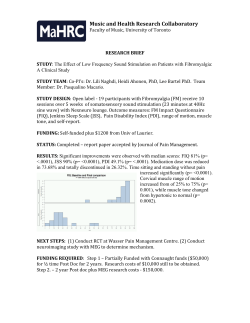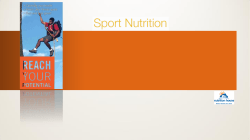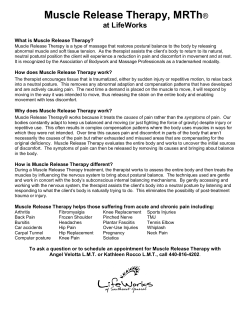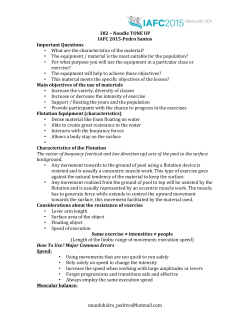
Antrim PE Revision Course AQA AS PED 1 Session 3c
Antrim PE Revision Course AQA AS PED 1 Session 3c Applied Physiology – Movement Analysis, Fitness & Training Analysis of movement (including planes and axes) • • • • • • • • • • • • Shoulder and elbow action in – Push-ups Over-arm throwing Forehand racket strokes Hip, knee and ankle action in: Running Kicking Jumping Squats Types of joint, articulating bones, joint actions Main agonists and antagonists Types of muscle contraction: isotonic (concentric and eccentric) and isometric related to the sporting actions. Understanding & Analysing Movement Axes of the body Transverse or horizontal axis Kick Jan05Q5 Planes of Movement Frontal Transverse Longitudinal Axis Sagittal Understanding & Analysing Movement Type of movement Description Type of movement Description Flexion Decreasing angle between 2 bones Extension Increasing angle between 2 bones Adduction Towards mid line of body Abduction Away from mid line of body Circumduction Movement of Rotation bone makes cone Supination Face up e.g. palms face up Eversion Sole of foot Inversion outwards at ankle Dorsiflexion Raising toes towards tibia Pronation Bone rotates around own axis Face down Sole of foot inwards at ankle Plantarflexion Pointing of the toes Understanding & Analysing Movement Construct a movement sequence using the following in the correct order:- Abduction, flexion, inversion, circumduction, supination, adduction, plantarflexion, extension, eversion, rotation, dorsiflexion, pronation Agonists and Antagonists • Agonist – Prime Mover Muscle or muscle group mainly responsible for a movement • Antagonist Muscle or muscle group that acts to produce the opposite action of the agonist Types of Muscle Action Isotonic Isometric Concentric Eccentric (shortening (Lengthening Constant length (no movement) under tension) under tension) Isokinetic Constant speed of movement Movement Analysis Plane & Axis Joint Type Bones in joint Joint Action Agonist Antagonist Contraction Type Levers • Three classes of levers • Examples of the use of levers in the body • Relationship of levers to effective performance – mechanical advantages and disadvantages and range and speed of movement. Levers - Types 1st Class 2nd Class 3rd Class Levers – Mechanical Disadvantage Work = Force × Distance MA tells how much the lever magnifies effort M Ad > 1 occurs if effort required less than load M Ad < 1 occurs if effort required greater than load MA - 1st class lever effort resistance effort arm resistance arm axis • Effort & resistance act on opposite sides of axis • It is the most versatile of the lever systems – Depending on effort arm distance can lift a large resistance or act at a small distance to move the resistance a greater distance M Ad either > or < 1 or = 1 (dependent upon axis) MA - 2nd class lever • Forces act on one side of the axis • M Ad always > 1(effort is always less than the resistance) Effort arm effort Resistance arm axis The effort must always move a greater distance than the resistance rd 3 class lever • Forces act on one side of the axis • M Ad always < 1 (effort always greater than the resistance) effort effort arm axis Resistance Jan03Q1 Resistance arm Tennis Ans Muscle pulls point of application through small arc Distal portion of the lever moves through large arc Large range of motion and speed of distal portion Applied Exercise physiology in practical situations • Principles of training – specificity, progression, over-training, overload, reversibility and tedium • FITT principles • Calculating work intensity for optimal gains through heart rate and Borg scale, weights – one rep max • Fitness testing – reasons for testing • Principles of maximal and sub-maximal tests • Limitations of testing, specific test protocols, issues relating to validity and reliability. • Physiological and psychological value of a warm-up and cool-down • Types of stretching exercises, active, passive, static and ballistic. • Principles of safe practice • Training methods – continuous, intermittent, circuit, weights, plyometrics and mobility training. Explanation of the principles of each method, specific examples, advantages and disadvantages. Fitness Questions - Exams Fitness Training Considerations Performer’s needs – base line Fitness components of activity Training principles Training methods Training year - major competitions Training principles (1) Specificity – relevant to task – energy system, body area, movement Progression – more intensity/ frequency/ duration Over-training – insufficient rest is harmful Reversibility – Lose quicker than you gain Tedium – variety, repetition is boring Training principles (2) – F.I.T.T. F – frequency (per day/week) I – intensity (% of max) T – time/duration T – type/mode (continuous/intermittent) Continuous training • Continuous running, swimming, rowing or cycling - trains aerobic system - develops endurance • Sub-maximal work • Higher intensity – anaerobic systems • Based on % of max HR (HR Zones) Determining intensity • Lactate sampling • Heart rate –Karvonen formula [(max HR - resting HR) x 0.6] + resting HR –Heart rate training zone • Training pace/intensity - % of maximum Heart rate zones • Measured as a percentage of maximum heart rate • Maximum heart rate (220 - age) • Unfit – train at 50-70% of max HR • Fit – train at 70-90% of max HR Borg Scale – rate of perceived exertion Intermittent training • Periods of work and recovery • Adjust frequency, duration, intensity and recovery period • Blocks of work = ‘sets’ • Sets composed of repetitions • Number of repetitions/intensity of the exercise –link to recovery interval – energy system • Circuit training, weight training, shuttles Circuit training • A series of exercises performed one after the • • • • • other – the circuit Each exercise exists at a ‘station’ Consecutive stations designed to stress different muscle groups Or different aspects of fitness - spread the fatigue. Usually designed to last 20 - 40 minutes Normally - 2-4 laps of the circuit, Rest interval decided between laps and/or stations. 35-60 25 Strength • Training programs that are concentric-only / eccentric-only do not yield as much strength gains as combined – because concentric contraction may use different motor units than eccentric contraction – because we are not able to maximally contract eccentrically (we are lengthening muscle) – delayed-onset muscle soreness METHODS Weighted vest running/jumping Towing (sled, tire, parachute etc) Uphill running, riding Sand/shallow water running Strength • plyometrics or “pre-loading” – eccentric-concentric sequence – muscle performs more positive work during concentric contraction – storage of elastic energy – altered cross-bridge attachment – more calcium release – activation of larger, stronger motor units PLYOMETRICS • Eccentric contraction (landing) Stretch-Shorten Cycle Stretch Reflex Elastic energy stored • Concentric – take off PLYOMETRICS • • • • • • • • Stretch-Shorten Cycle Stretch Reflex eccentric-concentric sequence muscle performs more positive work during concentric contraction storage of elastic energy altered cross-bridge attachment more calcium release activation of larger, stronger motor units Fitness – flexibility • Move joints through a wide range of movement (ROM) • Most activities because of need to stretch to reach • Limits to movement – bones, ligaments, muscles and tendons • Sit and reach test, goniometers Stretching Active Involves voluntary muscle contractions to achieve stretch Stretch held for 30-60 seconds Relax muscle of end of range Passive Use external force to increase range achieved – partner, gravity, body wt Forcibly increase range achieved Stretching - PNF • Best way of increasing flexibility • Hold stretch for 6 seconds • Stretch reflex inhibited • Isometric contraction • Increase stretch Training Overload Fatigue Theory of Supercompensation Under-Training Fitness Testing Tests for each component Name, describe, component, limitations Validity Actually measures what it claims Maximal - Sub-maximal Limitations Relationship of component to activity/game situation. Inter-relationship of components Reliability Variables accounted for/controlled Ethical Considerations If test is repeated should give same result Health and safety, tests to destruction Maximal and sub-maximal tests – exercise to exhaustion – need high motivation Maximal • Sub-maximal – exercise to less than maximal and extrapolating results (heart rate) to estimate maximal values Direct and indirect tests Most concerned with cardio-respiratory endurance/stamina - VO2 max Direct involves measuring VO2 max Indirect involves estimating VO2 max – by measuring heart rate Physiological tests Heart Rate • Pulse taking is cheap and simple • Pulse meter more accurate and less distracting; doesn’t require performer to stop Respiration Use breath volume bags (Douglas bags) linked to one-way valve to measure vital capacity Maximum expiration into the bag following a maximum inspiration Predictive tests • Maximum heart rate corresponds to exercise at a maximum workload • Heart rate is related to workload over a range of exercise intensities • Use heart rate measures to estimate maximum heart rate/workload Step Tests – protocol, step height cadence etc. Simple but outmoded Multistage shuttle run test • Predicts VO2 max • 20-metre shuttles using tape-recorded timing; progressive; maximal; accurate; large groups • Maximal – requires motivation; favours runners PWC170 cycle ergometer test • Measures aerobic fitness/stamina • Standardised workload undertaken – heart rate measured • Three workloads/heart rates taken • Data extrapolated to find workload achievable at heart rate of 170bpm • Accurate – measurement of both HR and workload Wingate power test • 30 seconds of all out cycling to determine anaerobic power • Workload calculated according to weight • Number of revolutions counted for every 5 seconds of test • Graph produced of power against time • Accurate – measurement of both power and time Objective, Subjective Tests Objective tests provide quantifiable measures of performance (metres/seconds/runs/points) Subjective tests provide judgments about quality of performance – no units Skill Testing Jan03Q5 Ans Validity Testing skills in isolation? Objectivity Measured success/outcomes the same as skilful play? Subjectivity Can you judge skilful play without measuring? Reliability Testing skills in performance situations? Warm Up • • • • • • Improves oxygen delivery via blood flow Improves chemical reactions for energy Sensitises nerves and improves conduction Movement rehearsal Reduces injury Blood flow to heart Cool Down •Active recovery 5-10 minutes light exercise •Static stretching 5-10 minutes • • • • Disperses waste products Reduces DOMS Reduce blood pooling –dizziness Slows heart rate
© Copyright 2025















